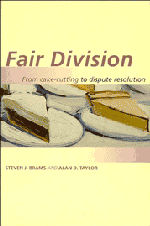Book contents
- Frontmatter
- Contents
- List of figures
- List of tables
- Acknowledgments
- Introduction
- 1 Proportionality for n = 2
- 2 Proportionality for n > 2: the divisible case
- 3 Proportionality for n > 2: the indivisible case
- 4 Envy-freeness and equitability for n = 2
- 5 Applications of the point-allocation procedures
- 6 Envy-free procedures for n = 3 and n = 4
- 7 Envy-free procedures for arbitrary n
- 8 Divide-the-dollar
- 9 Fair division by auctions
- 10 Fair division by elections
- 11 Conclusions
- Glossary
- Bibliography
- Index
9 - Fair division by auctions
Published online by Cambridge University Press: 05 July 2011
- Frontmatter
- Contents
- List of figures
- List of tables
- Acknowledgments
- Introduction
- 1 Proportionality for n = 2
- 2 Proportionality for n > 2: the divisible case
- 3 Proportionality for n > 2: the indivisible case
- 4 Envy-freeness and equitability for n = 2
- 5 Applications of the point-allocation procedures
- 6 Envy-free procedures for n = 3 and n = 4
- 7 Envy-free procedures for arbitrary n
- 8 Divide-the-dollar
- 9 Fair division by auctions
- 10 Fair division by elections
- 11 Conclusions
- Glossary
- Bibliography
- Index
Summary
Introduction
What do auctions have to do with fair division? In this chapter we will show that bidding for items, and awarding them to the highest bidder – or, possibly, splitting the award among two or more of the highest bidders – may provide a compelling means to allocate them.
There are a plethora of different auction procedures, including English auctions, Dutch auctions, sealed-bid auctions, Vickrey auctions, and many others. We have already alluded to English and Dutch auctions in connection with the last-diminisher procedure (section 2.3) and n-person proportional and envy-free procedures (sections 2.7 and 7.6). We also analyzed Knaster's procedure of sealed bids (section 3.2), comparing it with the AW procedure, in which players allocate points as if they were bidding (section 5.5).
The auction procedure we analyze in this chapter, in which bidding is carried out in two stages, is unorthodox. It has not heretofore been described or analyzed in any publications. We shall give reasons why we think this auction procedure is, in many situations, superior to others, some of which we shall discuss. But here we simply note that our analysis rests partly on ideas we developed in chapter 8, including that of adding a second stage, and having players successively eliminate weakly dominated strategies, in divide-the-dollar.
- Type
- Chapter
- Information
- Fair DivisionFrom Cake-Cutting to Dispute Resolution, pp. 178 - 203Publisher: Cambridge University PressPrint publication year: 1996



